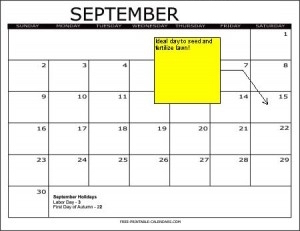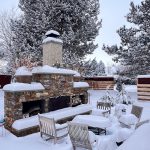
The grass seed installment in my lawn series! Text is continued from Yes Virginia, It’s Time For Your Lawn! part 3

Mid September is usually the perfect time to spread cool season grass seed and starter fertilizer. Your new lawn will have time to get established before winter sets in, that is if we have one, and before leaves removal needs to happen. So it’s time Virginia- for grass seed and fertilizer.
Do you ever go to the garden center or big box retailer and scratch you head in confusion at the assortment of offerings for lawn care, fertilizer, seed, etc. This one or that one before that one or this one?! It can be really baffling, and expensive. I’ll continue by making some sense of it all.
Virginia loves a year-round green lawn. The seed typically used in the central VA to produce that green is actually best suited for lawns of the Northern Piedmont and Blue Ridge Mountains areas. We are in a fringe zone making blends a good choice as they provide broader genetic diversity and range of tolerance to stress. Varieties such as Kentucky bluegrass, tall fescues as well as fine leaf fescues such as creeping red, hard, and sheep fescue and perennial ryegrass are all options. Fine fescues and chewings fescue have the best shade tolerance of all the cool-season grasses. Trade named grasses abound, and the county VA Extension offices and Virginia Tech have much information on lawn turf trials. A link to trail results and recommended grass seed list is: http://pubs.ext.vt.edu/CSES/CSES-17/CSES-17_pdf.pdf
Always look for and compare bag labels. Purchasing “CERTIFIED SEED” is a guarantee that the bag contains what is claimed. Notice the weed seed content in the label. Higher weed seed content = not good. FYI- grass seed blends are preferred in lieu of single varieties such as this bag of Kentucky 31.
The best guarantee of getting the specific variety or blend of turfgrass is to purchase CERTIFIED SEED. Follow the recommendation rate for application of seed for new lawns or overseeding. More is not better as the lawn can actually become too thick and the grass can choke itself out or create other issues.
Next… lawn fertilization and watering!
Related posts:
Tags: aerating lawn, Landscape design, lawn
Leave a Reply Cancel reply

More Story
Yes Virginia, It's Time For Your Lawn! part 3
Continued from Yes Virginia- It’s Time For Your Lawn! part 2 The earliest active growing season, i.e. fall, is the ideal...Subscribe to the Blog
Site Menu
Recent Posts
- What's a gardener to do... in winter?
Jan 22, 2024 - New Year, New Plans!
Jan 1, 2024 - The Thoughtful Host
Dec 7, 2023
- What's a gardener to do... in winter?

You may link to a post or take quotes if credit, including a link back, is given.
You may not take entire posts or photographs without asking.
Permission may be requested using the contact form .















Share On